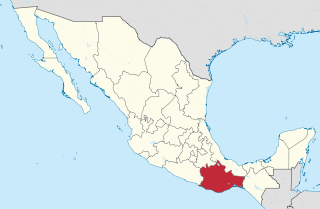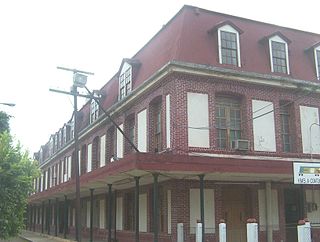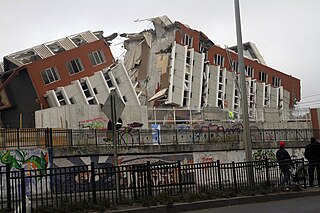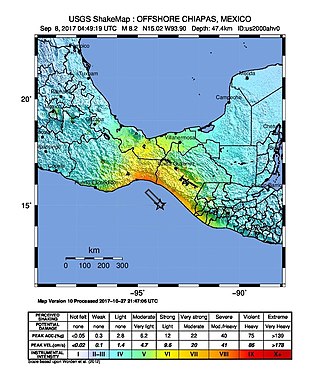
Oaxaca, officially the Free and Sovereign State of Oaxaca, is one of the 32 states that compose the Federative Entities of the United Mexican States. It is divided into 570 municipalities, of which 418 are governed by the system of usos y costumbres with recognized local forms of self-governance. Its capital city is Oaxaca de Juárez.

Coatzacoalcos is a major port city in the southern part of the Mexican state of Veracruz, mostly on the western side of the Coatzacoalcos River estuary, on the Bay of Campeche, on the southern Gulf of Mexico coast. The city serves as the municipal seat of the municipality of the same name. The city had a 2020 census population of 212,540, making it the third-largest city in the state after Veracruz and Xalapa. The municipality covers a surface area of 471.16 km2 (181.916 sq mi) and reported a population of 310,698 persons. The municipality population in 2015 was 319,187 a decrease of 9% over 2020.
Axochiapan is a city in the Mexican state of Morelos. It stands at 18°30′N98°45′W, at a mean height of 1,030 metres (3,380 ft) above sea level. It is surrounded by the State of Puebla to the east and south, Jonacatepec to the north, and Tepalcingo to the west.

Juchitán de Zaragoza is an indigenous town in the southeast of the Mexican state of Oaxaca. It is part of the Juchitán District in the west of the Istmo de Tehuantepec region. With a 2020 census population of 88,280, it is the third-largest city in the state. The majority of the indigenous inhabitants are Zapotecs and Huaves. The town also serves as the municipal seat for the surrounding municipality, with which it shares a name. The municipality has an area of 414.64 km2 and a population of 113,570, the state's third-largest in population.

Cuautitlán, is a municipality in the State of Mexico, just north of the northern tip of the Federal District within the Greater Mexico City urban area. The city of Cuautitlán is the municipal seat and makes up most of the municipality. The name comes from Nahuatl and means 'between the trees.'
An earthquake light also known as earthquake lightning or earthquake flash is a luminous optical phenomenon that appears in the sky at or near areas of tectonic stress, seismic activity, or volcanic eruptions. There is no broad consensus as to the causes of the phenomenon involved. The phenomenon differs from disruptions to electrical grids – such as arcing power lines – which can produce bright flashes as a result of ground shaking or hazardous weather conditions.

Izúcar de Matamoros is a city in Izúcar de Matamoros Municipality located in the southwestern part of the Mexican state of Puebla. The city serves as the municipal seat of the municipality. At the census of 2005 the city had a population of 41,042 inhabitants, while the municipality had a population of 69,413. The municipality has an area of 514.11 km², and stands at 1100 m above sea level. Its largest other communities are the towns of La Galarza and San Juan Raboso. It has many sights like the portales, and Santo Domingo, the biggest church in the city.

Nacozari de García is a small mining town surrounded by the Nacozari de García Municipality in the northeast of the Mexican state of Sonora.
Mecatlán is a municipality in the Mexican state of Veracruz. It is located in the north zone of the state, about 327 km from the state capital Xalapa. It has an area of 48.53 km2. It is located at 20°13′N97°41′W.

Matías Romero is a town and municipality in Oaxaca in south-western Mexico. It is named after Mexican politician and diplomat Matías Romero Avendaño. The municipality covers an area of 1,459.54 km². It is part of the Juchitán District in the west of the Istmo de Tehuantepec region. El Rio Corte in Colonia Cuauhtemoc is a popular tourist spot, wide and with excellent beaches.
Santo Domingo de Morelos is a town and municipality in Oaxaca in south-western Mexico. The municipality covers an area of 107.17 km². It is part of the Pochutla District in the east of the Costa Region.
Mazapiltepec de Juárez (municipality) is a town and municipality in the Mexican state of Puebla in south-eastern Mexico.

The 2010 Chile earthquake and tsunami occurred off the coast of central Chile on Saturday, 27 February at 03:34 local time, having a magnitude of 8.8 on the moment magnitude scale, with intense shaking lasting for about three minutes. It was felt strongly in six Chilean regions that together make up about 80 percent of the country's population. According to the United States Geological Survey (USGS) the cities experiencing the strongest shaking—VIII (Severe) on the Mercalli intensity scale (MM)—were Concepción, Arauco, and Coronel. According to Chile's Seismological Service, Concepción experienced the strongest shaking at MM IX (Violent). The earthquake was felt in the capital Santiago at MM VII or MM VIII. Tremors were felt in many Argentine cities, including Buenos Aires, Córdoba, Mendoza, and La Rioja. Tremors were felt as far north as the city of Ica in southern Peru.
Guadalupe Victoria, also known as the 43, is a small city in the state of Baja California in northern Mexico. Its population at the 2018 census was 20,222 inhabitants. It is located in the municipality of Mexicali and serves as a borough seat of its surrounding area.

Istmo de Tehuantepec is the largest region of the state of Oaxaca, located in southwestern Mexico.
The 2012 Guerrero–Oaxaca earthquake struck southern Mexico with a moment magnitude of 7.4 at on Tuesday, 20 March. Its epicenter was near Ometepec, in the border between the states of Guerrero and Oaxaca. With a shallow focus of 20 km, the earthquake caused strong shaking over a large area along the Oaxaca–Guerrero border and the adjacent Pacific coastline. Significant tremors were felt in areas up to several hundred kilometers away, including Mexico City and also in Guatemala. Two people were killed and over 30,000 houses were damaged or destroyed.

The 2017 Chiapas earthquake struck at 23:49 CDT on 7 September in the Gulf of Tehuantepec off the southern coast of Mexico near the state of Chiapas, approximately 87 kilometres (54 mi) southwest of Pijijiapan, with a Mercalli intensity of IX (Violent). The moment magnitude was estimated to be 8.2.

The 2017 Puebla earthquake struck at 13:14 CDT on 19 September 2017 with an estimated magnitude of 7.1 and strong shaking for about 20 seconds. Its epicenter was about 55 km (34 mi) south of the city of Puebla, Mexico. The earthquake caused damage in the Mexican states of Puebla and Morelos and in the Greater Mexico City area, including the collapse of more than 40 buildings. 370 people were killed by the earthquake and related building collapses, including 228 in Mexico City, and more than 6,000 were injured.

The 1920 Xalapa earthquake was the deadliest in Mexico's history prior to 1985—killing at least 648 people. It occurred on January 3 at 22:25 local time, during a period of political unrest in the country. Mudflows and landslides triggered by the shock destroyed buildings in rural towns across the states of Veracruz and Puebla, causing most of the deaths. The earthquake was attributed to a shallow fault in the Trans-Mexican Volcanic Belt. It measured moment magnitude 6.3–6.4 and had a hypocenter depth of <15 km (9.3 mi). The Mexican government took immediate action in the aftermath—providing assistance and establishing communication services. Severely damaged towns including Xalapa were rebuilt, while others had to be abandoned. Help to survivors also came from civil society groups, civilians, and the Catholic Church. The earthquake's aftershocks were studied by scientists to determine its seismological characteristics.
The 1979 Petatlán earthquake, also known as the IBERO earthquake occurred on March 14 at 05:07 local time in the Mexican state of Guerrero. The earthquake had a surface wave magnitude of Ms 7.6 or moment magnitude of Mw 7.4 and maximum Modified Mercalli intensity of VIII (Severe). The epicenter, onshore, was located 12 km south southeast of Vallecitos de Zaragoza.














